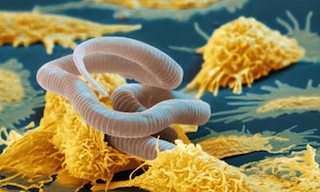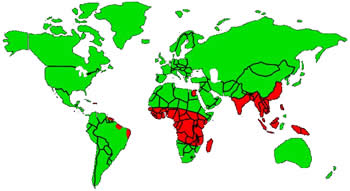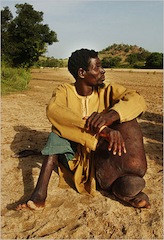Microbewiki:Lymphatic Filariasis: Difference between revisions
| Line 8: | Line 8: | ||
Currently nearly 1.4 billion people are at risk of Lymphatic Filariasis. Worldwide, the disease affects approximately 120 million people in 73 countries. It is commonly found in tropical and sub-tropical environments, such as parts of Asia, Africa, and Western Pacific regions. It has also been documented in parts of the Caribbean and South America, but is much less common. It is most prolific in Africa and the Southern Asian countries. Because it takes hundreds of bites from infected mosquitos, short-term tourists are not at risk of Elephantiasis. | Currently nearly 1.4 billion people are at risk of Lymphatic Filariasis. Worldwide, the disease affects approximately 120 million people in 73 countries. It is commonly found in tropical and sub-tropical environments, such as parts of Asia, Africa, and Western Pacific regions. It has also been documented in parts of the Caribbean and South America, but is much less common. It is most prolific in Africa and the Southern Asian countries. Because it takes hundreds of bites from infected mosquitos, short-term tourists are not at risk of Elephantiasis. | ||
==Transmission== | ==Transmission== | ||
A Lymphatic Filariasis infection spreads from one person to another through mosquito bites. The adult | A Lymphatic Filariasis infection spreads from one person to another through mosquito bites. The main mosquito vectors used to transmit the parasite are Anopheles (Africa), Aedes (Asia and Pacific), and Culex (Americas), all of which typically feed at night. Due to their vectors’ nocturnal tendencies, the microfilariae have a nocturnal periodicity. During the day the microfilariae stay in the deep tissue veins. After nightfall they begin their circulation throughout the bloodstream where they can be taken up by their mosquito vector. The adult parasites live within human lymphatic vessels. Here, they reproduce and generate millions of microscopic offsprings known as microfilariae. Due to their vectors’ nocturnal tendencies, the microfilariae have a nocturnal periodicity. During the day the microfilariae stay in the deep tissue veins. After nightfall they begin their circulation throughout the bloodstream where they can be taken up by their mosquito vector. When the mosquito feeds on the host’s blood they take up the microfilariae, who will now grow and develop within the mosquito. Once reaching the infective stage larvae (1-3 weeks) within the mosquito, the parasites will be deposited into a new host upon the mosquito’s next feed. Upon entering the new host’s blood stream, the parasites make their way to the host’s lymphatic system. Once reaching the lymph nodes and lymphatic vessels, the parasites continue their development into adult worms. The adult parasitic worms range from 2 to 4 inches in size depending on their gender. Males typically grow to approximately 2 inches in length, while their female counterpart can grow to 3 to 4 inches long. The maturation process from infective stage larvae to adult worm takes approximately six months. | ||
==Pathogenesis and Clinical features== | ==Pathogenesis and Clinical features== | ||
[[Image:Lymph_man.jpeg|thumb|400px|right|''Severely disfigured leg due to Lymphatic Filariasis. From: http://www.nytimes.com/ [http://www.nytimes.com/slideshow/2006/04/08/world/20060409_LYMPH_SLIDESHOW_2.html?_r=0]] | [[Image:Lymph_man.jpeg|thumb|400px|right|''Severely disfigured leg due to Lymphatic Filariasis. From: http://www.nytimes.com/ [http://www.nytimes.com/slideshow/2006/04/08/world/20060409_LYMPH_SLIDESHOW_2.html?_r=0]] | ||
Revision as of 10:01, 23 July 2013


Description
Elephantiasis (also called Lymphatic Filariasis) is a disease caused by parasitic thread-like roundworms. Worldwide, most cases of Elephantiasis are caused by Wuchereria bandcrofti. However, in Asia the disease is also caused by Brugia malayi and B. timori. The parasitic worms only live in the body’s lymphatic system. The lymphatic system is a network of tubes throughout the body that is responsible for draining fluids out of the tissues. The lymphatic system also helps protect the body from infection and disease. Once in the lymphatic system, the parasites can live for 5-7 years, reproducing and increasing the severity of the disease. Worldwide, Lymphatic Filariasis is the number one cause of permanent disability.
Epidemiology

Currently nearly 1.4 billion people are at risk of Lymphatic Filariasis. Worldwide, the disease affects approximately 120 million people in 73 countries. It is commonly found in tropical and sub-tropical environments, such as parts of Asia, Africa, and Western Pacific regions. It has also been documented in parts of the Caribbean and South America, but is much less common. It is most prolific in Africa and the Southern Asian countries. Because it takes hundreds of bites from infected mosquitos, short-term tourists are not at risk of Elephantiasis.
Transmission
A Lymphatic Filariasis infection spreads from one person to another through mosquito bites. The main mosquito vectors used to transmit the parasite are Anopheles (Africa), Aedes (Asia and Pacific), and Culex (Americas), all of which typically feed at night. Due to their vectors’ nocturnal tendencies, the microfilariae have a nocturnal periodicity. During the day the microfilariae stay in the deep tissue veins. After nightfall they begin their circulation throughout the bloodstream where they can be taken up by their mosquito vector. The adult parasites live within human lymphatic vessels. Here, they reproduce and generate millions of microscopic offsprings known as microfilariae. Due to their vectors’ nocturnal tendencies, the microfilariae have a nocturnal periodicity. During the day the microfilariae stay in the deep tissue veins. After nightfall they begin their circulation throughout the bloodstream where they can be taken up by their mosquito vector. When the mosquito feeds on the host’s blood they take up the microfilariae, who will now grow and develop within the mosquito. Once reaching the infective stage larvae (1-3 weeks) within the mosquito, the parasites will be deposited into a new host upon the mosquito’s next feed. Upon entering the new host’s blood stream, the parasites make their way to the host’s lymphatic system. Once reaching the lymph nodes and lymphatic vessels, the parasites continue their development into adult worms. The adult parasitic worms range from 2 to 4 inches in size depending on their gender. Males typically grow to approximately 2 inches in length, while their female counterpart can grow to 3 to 4 inches long. The maturation process from infective stage larvae to adult worm takes approximately six months.
Pathogenesis and Clinical features


In humans, 90% of cases of elephantiasis are caused by W. bancrofti. Infections of the W. bancrofti parasite occurs in three stages.
1. During the asymptomatic stage there are high numbers of microfilariae circulating in the blood with very few, if any, adult parasites in the body. This period without symptoms can sometimes last years.
2. During the acute stage the adult female worm expresses antigens that are recognized by the host’s immune system. This recognition elicits a host inflammatory response. The adult worms, living in the lymph nodes, obstruct the lymphatic system causing a disruption of the flow of lymph fluid. This is known as lymphedema. Lymph fluid is responsible for draining fluid out of the tissues. The host will show symptoms of such as fever, chills, tender skin in the infected area, painful lymph nodes, and skin infections. These symptoms typically last 5 to 7 days.
3. The chronic phase is characterized by severely dilated lymph vessels, hydrocele, and swelling and thickening of the skin typically in the legs. This is commonly knows as elephantiasis. Men are susceptible to hydrocele, swelling of the scrotum. This is caused by lymph fluid collecting in the scrotum, causing it to greatly increase in size.
Many people affected by this Elephantiasis are unable to work due to their disfigurement, causing their families to further suffer due to their reduced income. Because the lymphatic system is also responsible for protecting the body against disease and infection, damage to the lymphatic system due to Elephantiasis has also led to diseases such as tuberculosis, leprosy, and numerous sexually transmitted diseases. The damage done due to elephantiasis is irreversible. The affected limbs cannot be surgically drained due to the fact that the lymph fluid swells the tissue instead of merely collecting in one area. The overstretched lymph nodes will never return to normal size, hindering their function. Eventually the parasites will die inside the lymph nodes.
Diagnosis
Treatment
Prevention
References
1 Conway, Tyrrell. “Genus conway”. “Microbe Wiki” 2013. Volume 1. p. 1-2.
Created by {Kyle TrInidad}, students of Tyrrell Conway at the University of Oklahoma.
